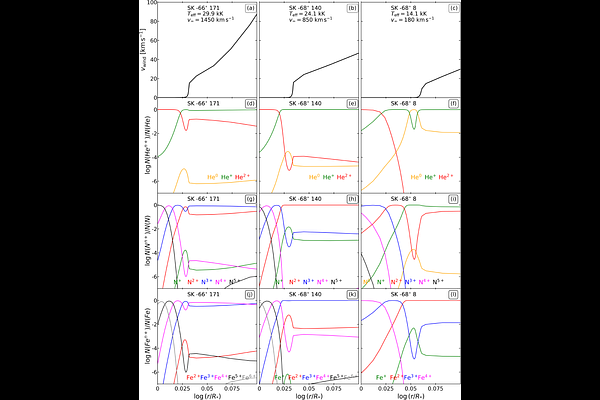X-Shooting ULLYSES: Massive stars at low metallicity. XIII. Putting the bi-stability jump to the test in the LMC

X-Shooting ULLYSES: Massive stars at low metallicity. XIII. Putting the bi-stability jump to the test in the LMC
T. Alkousa, P. A. Crowther, J. M. Bestenlehner, H. Sana, F. Tramper, J. S. Vink, D. Pauli, J. Th. van Loon, F. Najarro, R. Kuiper, A. A. C. Sander, M. Bernini-Peron, The XShootU collaboration.
AbstractWe aim to investigate the theoretical bi-stability jump, which predicts an increase in mass-loss rates below 21 kK. We further aim to constrain the photospheric and wind parameters of a sample of 16 LMC late-O and B supergiants. We utilise the 1D, non-LTE radiative transfer model CMFGEN in a grid-based approach and subsequent fine-tuned spectroscopic fitting procedure to determine the stellar and wind parameters of each star. We apply this method to ultra-violet data from the ULLYSES programme and complementary optical data from the XShootU collaboration. We also utilise evolutionary models to obtain the evolutionary masses and compare them to our derived spectroscopic masses. We derive physical parameters and wind properties of 16 late-O and B supergiants that span a wide $T_{eff}$ range of 12-30 kK, surface gravity range $\log{g/cm~s^{-2}}$ of 1.8-3.1, and a mass-loss rate range of $10^{-7.6}-10^{-5.7}M_{\odot}yr^{-1}$. We also compare our results to previous studies spectroscopic studies of LMC OB stars. We find that our derived photospheric and wind properties are consistent with multiple previous studies. For most of our sample, we find that the evolutionary masses and spectroscopic masses are consistent. Our results do not reproduce a bi-stability jump in any temperature range, but rather a monotonic decrease in mass-loss rate at lower temperatures. We obtain a terminal wind velocity-effective temperature relation for LMC supergiants. We find that our derived mass-loss rates do not agree with predictions from any of the numerical recipes. This is also the case for the ratio of the terminal wind velocity to the escape velocity $v_{\infty}/v_{esc}$, and we derive a $v_{\infty}/v_{esc}$-$T_{eff}$ relation. We find that wind properties are metallicity dependent from a comparison with a previous SMC study, and we obtain a new modified wind momentum-luminosity relation.